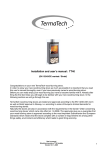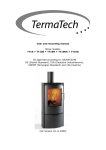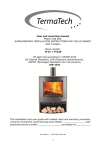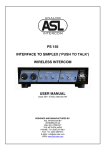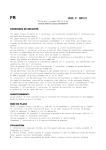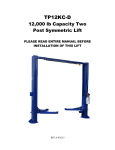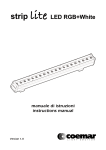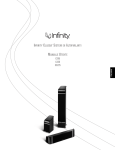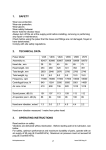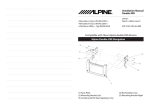Download tt1_tt2_tt3 user manual
Transcript
User and mounting manual Stove models: TT1,TT2 and TT3 models CE approved according to: DS/EN13240 DS (Danish Standard), DIN (Deutsche Industrienorm), SINTEF (Norwegian Standard) and 15A (Austria) Version 18.11.09 english Congratulations on your new wood-burning stove. We thank you for choosing a TermaTech wood-burning stove and wish you many cosy and warm moments in the future. Before using the stove you should read the user and mounting manual so you are familiar with the legal requirements as well as the instructions regarding maintenance. By this it is ensured that the product works as it is intended and you get the most out of your investment for many years to come. 1. 2. 3. 4. 5. 6. Installation instruction Lighting instruction Maintenance Hints Remedy of malfunctions / FAQ Technical specifications 1. INSTALLATION INSTRUCTION The stove is intended for ”intermittent combustion”. It is not meant to “heat over” at night. By following the instruction below in “Lighting instruction” the best and most environmentally friendly combustion is achieved. The wood-burning stove is delivered ”ready for mounting” (the exhaust branch may need to be screwed on) and must be connected to the chimney with a smoke pipe. The connection between stove and chimney must, as far as possible, be mounted in one straight piece (with as few bends as possible) and as minimum horizontally, but preferably rising from the stove to the chimney. Joints must be tight. Remember that is has to be possible to clean the pipe (possibly with a cleaning hatch on the pipe). Any unauthorised changes to the wood-burning stove will be viewed as a structural change and thereby the warranty will be void and is also a risk to safety. In the door on your TT stove there is a spring that makes the door close by itself when you let go of the handle. This closing device is not a demand in the UK, Denmark and many other countries and can therefore be removed. In the bottom hinge the split with lentil head is removed which removes the tension from the spring. This is most easily done by using a small screw driver and side-cutting pliers. National and European norms The regulations in force at the time in question, including those that refer to national and European standards, must be respected when installing the woodburning stove. Contact your local dealer for further advice and guidance in connection with mounting. Notify your Hetas installer before you use your wood-burning stove. It must be ensured that there is sufficient airflow for the combustion in the stove, so care must be taken concerning closely shut windows and doors that may hinder the flow of air to the combustion. Safety references The surface of the stove as well as knobs, handle, window, smoke pipe, etc. become very hot when the stove is in use. Touching these parts without necessary protection (glove or other protective material) can lead to burns. Remember to make children aware of this danger and make sure to keep them away from the wood-burning stove when it is in use. For this purpose TermaTech offers various grates for the protection of children. (Ask your dealer) Allowed in the wood-burning stove Only use dry and clean wood for combustion in the wood-burning stove. Maximum size of logs used in the stove is up to 30 cm in length and 10 cm in diameter. Only use dry wood. The burning of waste, synthetic materials and other treated or impregnated materials is not allowed as it is very hazardous to the environment. Furthermore the stove and the chimney will be damaged by these materials. There is a danger of emission of unhealthy substances which can also lead to complaints from neighbours. Dry and clean wood has a maximum of 20% water which is achieved with outdoor storage for between 1 year (soft wood) and 2 years (hard wood). The wood must be in contact with air during storage so the moisture can get out of the wood. Firewood is not meant to ”burn overnight”. Never close off the airflow completely, instead let the fire die out and light it again when you need it. We warn against closing off the airflow completely. The wood-burning stove can only burn sensibly and environmentally friendly if there is sufficient airflow for the combustion. Cleaning and checks The wood-burning stove and the smoke pipe should be checked and cleaned once a year. The chimney must also be cleaned by the chimney sweep who will set the necessary intervals for cleaning / sweeping. The wood-burning stove should be checked by a professional about once a year. Combustion air Combustion air is a precondition for a good and clean combustion. The air is normally taken from the room where the wood-burning stove is mounted, however in some circumstances it may be necessary to provide extra air in the room where the stove is placed. This can e.g. be done by mounting an air valve in the room’s outer wall. Air valves that supply necessary combustion air must be kept free from blockage. An exhaust fan in the same room or close to the wood-burning stove can also have a negative effect on the combustion (at worst it can lead to exhaust gases in the room, even with the stove door closed). Therefore, in the above case, the wood-burning stove and the exhaust fan must never be in use at the same time. Distance to flammable material: The stove must be put on a non inflammable foundation. This foundation must as a minimum cover 150 mm on each side of the stove and 300 mm in front of the stove. For inflammable materials like walls of wood or other inflammable materials, furniture, etc. the following minimum distances apply for safety reasons: 150 mm behind the stove to flammable material. 350 mm beside the stove to flammable material. 900 mm in front of the stove to flammable material. Distance to non-flammable materials: It is recommended that there is a minimum of 80-100 mm behind and beside the stove so the stove can dispose of the heat, this distance makes cleaning of and around the stove easier. In addition, refer to the relevant Building Regulations. Requirements for the chimney: The chimney must be of sufficient height so the draught conditions are okay the smoke does not bother anyone. Good draught in the chimney is crucial to the stove working as intended and burns as environmentally friendly as possible. The height of the chimney must typically be a minimum of 3.5 m from the top of the stove to the top of the chimney. The chimney must have a minimum internal diameter of Ø150mm. The chimney must be equipped with an easily accessible cleaning hatch. All joints and connections must be tight and the chimney must be able to provide a draught of at least 1.2 mm water gauge (12Pa). It is possible to connect the wood-burning stove to chimneys that are also used for other purposes. However, the concrete conditions must be assessed by the fitter and/or chimney sweep. If the stove is to be mounted with back exit the following is done: The round, welded or screwed cover plate at the back of the stove is removed. Then the cut-out piece on the base-plate is removed (the thin division plate). Be careful not to drop the piece between the back plate and the stove! This is best done with a screwdriver / chisel or pliers. Finally the screwed smoke cover is removed and then the exhaust branch can be mounted. Remember to fix the smoke cover at the top of the stove before use. Demands for the floor: The foundation must be able to bear the stove and possibly the chimney’s weight. Regulations: When your new stove has been mounted the installation has to be reported to the local Hetas installer / building control. The Hetas installer / building control must inspect the installation and clean the chimney in the future. Caution: TT1W – wall mounted You should always ask your stove dealer to mount the TT1W on the wall. Together with the TT1W there is a wall hanging plate, where the stove shall be mounted on. The wall hanging plate must be carefully and secure fastened to the wall, before the stove can be mounted. It is very important to use screws and / or other materials, which are working together with the materials of the wall. The stove has a weight of approx. 100 kg. Ask your Hetas installer or your stove dealer, if you have further questions about security and local rules. If the TT1W has to be mounted on a wall, you have to make sure, that you keep a distance of at least 325mm between floor and stove. 2. LIGHTING INSTRUCTION The first time: The first time the stove is lit is must be done gently as all the materials need to get use to the heat. The Senotherm varnish that the stove is painted with will harden the first couple of times the stove is heated, and it may cause some odour nuisances. So make sure that you have proper ventilation. Do not touch the painted surface, when the stove is hot. The painting has to harden up first. Use of the stove: Below is the procedure used for testing/approval of the stove. It is this procedure that will lead to the best combustion for the given chimney. Firewood amount and damper setting can be adjusted to the individual need for heating and the draught in the concrete chimney. Lighting and continuous firing at EN-testing 1. The ashpan must always be closed completely, also when you light the fire. The damper/start-up device can be opened (the knob on the ashpan moved 2. 3. 4. 5. 6. to the right) for a few minutes at lighting. Put about 10 kindling sticks (dia. 2-3 cm) in the bottom of the stove, laid in a criss-cross pattern as a log house. Put 2 firelighters in the middle and light them. Leave the door ajar so there is an opening of about 2-3 cm. Leave the stove like that for about 8-10 minutes before you close the door completely. Stay by the stove as long as the door is ajar. Make sure the damper on the right side of the stove is pulled out (open) When the fire has burned to embers (there are no more flames) open the door gently so the ash is not whirled out through the door. Gently spread out the embers with a poker so they are even. Put 2-3 pieces of firewood in the stove, about 1.7 kg total. The pieces are put in the bottom of the stove and parallel to the front of the stove with equal distance to the stove’s sides and with mutual distance of about 1 cm. The front piece is best lit if it has a split side that is turned to the door and one in the embers. Close the door completely immediately. The knob/damper on the right side of the stove, is opened so it is about 2/3 open (pulled out) and after about 2 minutes the damper is set to about 1/3 open. How much the damper should be open depends on the individual chimney’s draught, but the flames should now stabilise to a calm fire. When the wood has burned to embers (after about 1 hour) you start again from point 3. 3. MAINTENANCE – always use original parts Maintenance and cleaning of the stove should only be performed when the stove is cold. The daily maintenance is limited, but once a year the stove should get thorough maintenance. The combustion chamber should be cleaned for ashes and soot and the door hinges and the closing mechanism should be lubricated with copper grease. The surface is maintained by brushing it with a soft, long-haired brush or by using the vacuum cleaner with a brush. The stove can also be dusted with a duster. Always remember: only when the stove is cold. Jointings can look okay, but they collapse under the heat and thereby lose the ability to keep the stove sealed. Jointings should be changed as needed as it is important to good combustion and a clean window that the stove is sealed. The insulation plates in the combustion chamber that are broken or worn can easily be changed as they are loosely fixed. The material used is called Vermiculite and is a porous, but very suitable insulation material. It has no effect on the stove’s efficiency that the insulation cracks. However, it should be changed when the wear surpasses half of the original thickness. Painting the stove with Senotherm-spray can cover spots or small scratches from kettles and such. Larger damages needs to be ground with fine steel wool, vacuumed and then sprayed. The can has to be shaken vigorously and then sprayed on at a distance of 15-20 cm. It is very important that the stove is not in use and completely cold before you use the spray due to the fire hazard. In order to keep the stove’s varnished surfaces looking nice for years to come you should try to avoid touching the varnished surfaces when the stove is hot. Make sure to have sufficient ventilation when using spray paint. Glass normally does not need any maintenance apart from cleaning. This is most easily done by using TermaTech’s glass cleaner. Remember only to use glass cleaner when the stove is cold. Original parts which need to be changed due to wear can be found at your dealer. Because of fit etc. only original parts from TermaTech should be used. Flue / Chimney must be swept on regular occasions, as per manufacturers recommendations. Right to claim compensation for defective product is under current law. When stating deviations the use of the product must be suspended immediately and the dealer must be contacted. 4. HINTS Lighting after long break If the stove has not been used for a long time the chimney should be checked for possible blockage before lighting. Furthermore it is a good idea to remove any dust from the wood-burning stove as it might smell after a long break. Chimney fire In case of chimney fire the doors, drawers and damper of the wood-burning stove must be closed immediately in order to shut of the supply of oxygen. The relevant authorities must be notified if necessary. The stove must not be used until the chimney has been inspected. Kindling is the designation for finely split wood/sticks that are about 20 cm long and have a diameter of 2-3 cm. Wood like birch, beech, oak, ash, elm, pine wood and wood from fruit trees is all suitable for splitting into firewood. Waste products like pressure-treated wood, chipboard, coloured brochure or glossy paper must not be used in a wood-burning stove. They develop hydrochloric acid or heavy metals which cause a lot of damage to the stove and the environment. Firewood should have a diameter of 7-9 cm and be no more than about 30 cm long, otherwise it will get too close to the side of the stove (at the DStesting firewood at a length of 28 cm was used). The most important thing for good combustion is that the wood is dry (15-20% moisture). If the firewood is too wet it is difficult to get it to burn, the chimney draught is nonexistent, there is a lot of smoke and the exploitation is lower as the water has to evaporate first. Furthermore there may be damage to the stove and the chimney in the shape of shining soot and tarry deposits. At worst it can cause a chimney fire. If the firewood is too dry it will burn too quickly. Often the gasses in the wood are released faster than they can burn and some go unburned through the chimney. This also gives lower exploitation and harms the environment. So it is a balance that is quite easy to find with a little practise. See also below under Storage. Bio-briquettes can be used, but they develop a lot of ash and dust. Put in max. 2 kg per hour. Energy coke must not be used as it contains a lot of sulphur which wears on a stove, the chimney and the environment. The life of stove and chimney will be significantly reduced by using this firing type and the right to claim compensation for the product is void. Storage of the firewood is best under a roof, however with good ventilation, e.g. in a carport or under a shed roof. Place the wood on a wooden pallet or the like so it is free from the ground. Fresh wood that has been sawed and split must be stored for about 1-2 years this way until the moisture in the wood is down to 15-20%. The ashes can be put in the rubbish bin for garbage collection. The ashes should always have cooled for 1-2 days before it is put in the rubbish bin, as there might still be embers that can light garbage or a garbage bag. Regulation and smoke damper: If one is fixed in the chimney it should not close of more than 80% of the internal diameter of the chimney. 5. MALFUNCTIONS If problems should occur with the use of the stove the cause can possibly be found below. If not, then you are always welcome to contact your dealer. The stove is difficult to control – it burns too fast If the stove is new, then check that the directions have been followed. If the stove is more than 1 year old or if it has been used heavily, then the jointings may need to be changed. If the jointings sit for too long the heat makes them lose their ability to keep the stove sealed. Check that the ashpan is closed completely. If there is heavy draught in the chimney it may be necessary to fit a damper in it. The stove has poor draught after installation Check that the mounting instructions have been followed. It is especially the conditions surrounding the chimney that may cause problems. Are diameter and length okay, is it sealed, are smoke pipe and junctions sealed? Is the cleaning hatch sealed? You may need to contact a chimney sweep to remedy the problem as the chimney may be blocked. Smoke at soot smell This can be caused by down-draught in the chimney and most often happens in specific wind directions. The chimney may be too short for the ridge or trees may have grown and are creating turbulence. Remember not to open the door while there are flames. The stove is difficult to light and may die out There may be a number of causes. The most typical are: The damper is not sufficiently open. The firewood is too wet. The draught in the chimney is too small or maybe it is blocked or leaking. The ember layer was too small/incinerated and did not give enough heat to light the logs. Possibly give some start-up air to the fire by opening the damper on the ashpan (to the right) to get the stove going again. Then the damper has to be closed again. Depending on the problem it may be necessary to contact the dealer, installer or a chimney sweep. The glass soots up The wood is too moist. Lack of draught in the chimney. Check that the damper is not closed. Door is closed too early at lighting (point 3 section 2). 6.TECHNICAL SPECIFICATIONS TT1, TT1z, TT1W, TT2, TT3, TT3S, TT3H, TT3HS Height: 980 mm (TT1,TT2,TT3) 653mm (TT1W) 1016mm(TT3S) 1200mm (TT3H) 1238mm (TT3HS) Width: 480 mm (TT1,TT1W,TT2) 500mm (TT3,TT3H) 546mm (TT3S, TT3HS) Depth: 411 mm (TT1,TT1W) 430 mm (TT2) 478mm (TT3,TT3H) 468mm(TT3S+TT3HS) Weight: 121kg 101kg 192kg 140kg 250kg (TT1,TT2,TT3) (TT1W) (TT3S) (TT3H) (TT3HS) Average values for testing of TT1, TT2, TT3 models: Exhaust gas temperature Exhaust gas mass flow Effect degree Nominal effect Uptake 244 °C 6,0 g/s 76% 5,1 kW 12 Pa













